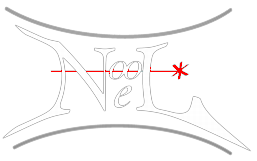University of Rome "Roma Tre", Department of Industrial, Electronic, and Mechanical Engineering, CNISM
The University "Roma Tre", established in 1992, has developed with NooEL a
strong commitment in Optoelectronics and Photonics, carrying out advanced
research in several areas of nonlinear optics, nanophotonics and near infrared detection.
Publication highlights
E. Calisto and G. Assanto, Direction-dependent optical solitary waves in nematic liquid crystals, Phys. Rev. A 108 (4), 053509
Abstract:
We investigate the optical propagation of reorientational solitary waves in nonuniformly oriented planar samples of thermotropic liquid crystals in the nematic phase. A nonsymmetric distribution of the optic axis, across either the longitudinal or transverse coordinates, entails nematicon paths affected by the side of the cell where the excitation is launched, i.e., direction-sensitive trajectories. We analyze the effect with reference to realistic samples encompassing a linearly modulated orientation vs either length or width, presenting nonlinear models and the outcome of numerical experiments. We briefly discuss the resulting nonspecular transmission in terms of optical nonreciprocity and isolation.
Gaetano Assanto, Noel F. Smyth, Spin-optical solitons in liquid crystals, Phys. Rev. A 102, 033501
Abstract:
In the framework of nonlinear spin optics, we investigate self-confined light beams in reorientational nematic liquid crystals. Using modulation theory and numerical experiments, we analyze spatial solitary waves supported by the geometric phase arising in a uniaxial when subject to a nonlinear modulation of its optic axis distribution. Spin evolution and optical reorientation in an index-homogeneous medium give rise to a longitudinally periodic, transversely inhomogeneous potential able to counteract the diffraction of a polarized bell-shaped beam, generating a spin-optical solitary wave. Spin-optical solitary waves evolve in polarization and have an oscillatory character in amplitude, size, and ellipticity.
Michal Kwasny, Miroslaw A. Karpierz, Gaetano Assanto, Urszula A. Laudyn, Optothermal vortex-solitons in liquid crystals, Opt. Lett. 45 (8), 2451
Abstract:
We report on vortex-solitons generated in dye-doped nematic liquid crystals by a purely optothermal nonlocal nonlinearity. This response not only supports stable doughnut-shaped ordinary-wave beams with orbital angular momentum, but also provides self-confined solitary waves with excellent trajectory and profile stability over time. Using an interferometric technique, we also investigate the role of nonlocal nonlinearity in the non-illuminated axial region.
Conferences
Future
Recent
European Material Research Society - Fall Meeting - EMRS2023
16th European Conf. on Liquid Crystals (ECLC 2023)
NOMA 2023 - Novel Optical Materials and Applications
